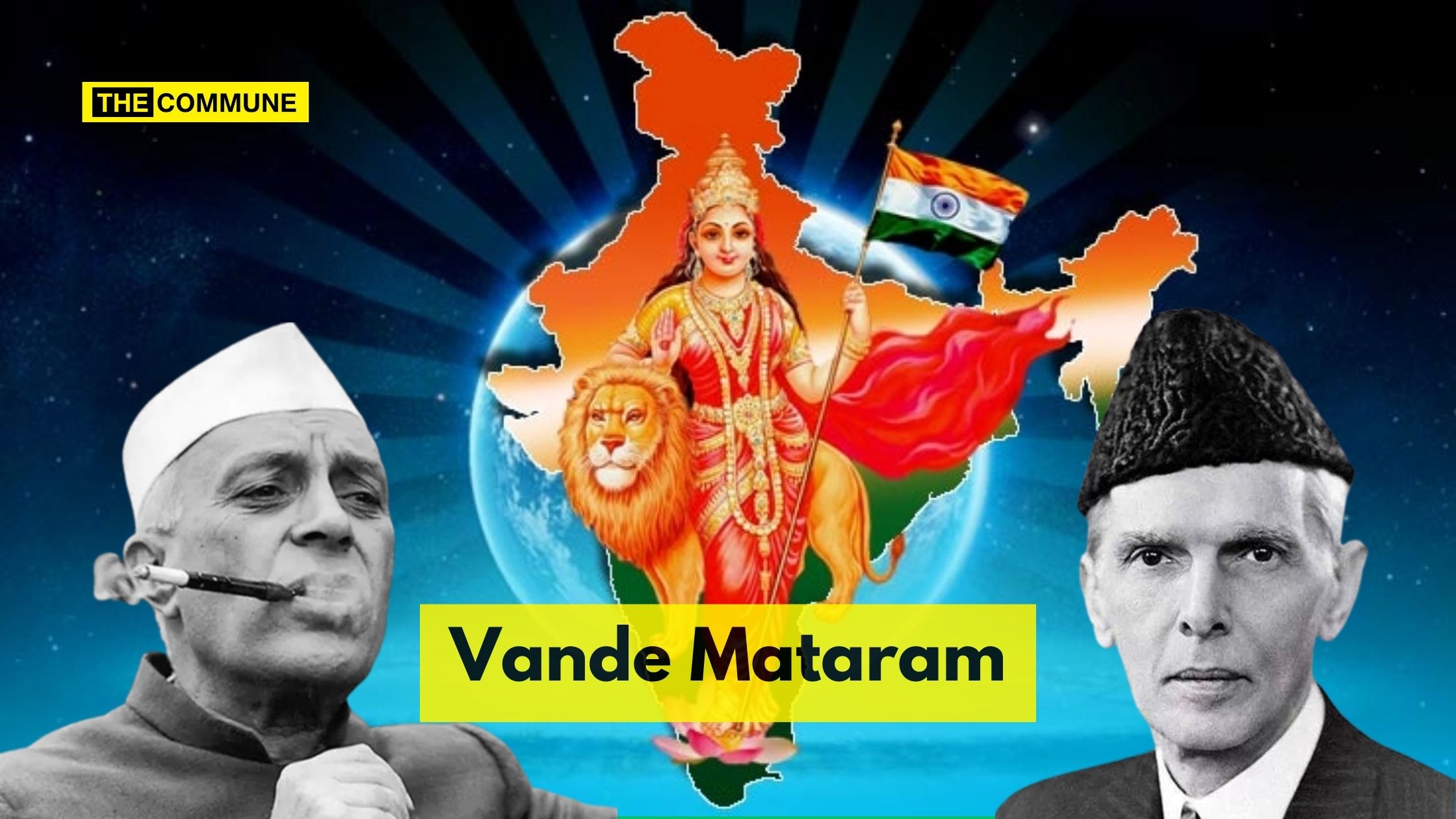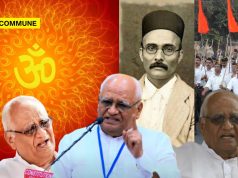
During his speech against the No-Confidence Motion, Prime Minister Narendra Modi on 10 August 2023 chastised the Congress calling them as people who dismembered the Vande Mataram song in response to Rahul Gandhi’s “Bharat Mata was murdered in Manipur” remark made in the Lok Sabha.
Prime Minister Narendra Modi was referring to how Congress owing to its policy of minority appeasement and keeping Mohammad Ali Jinnah in good humour, dropped verses that hailed Bharat Mata equating her to Hindu Gods.
Vande Mataram, An Ode To Mother India
“Vande Mataram”, pronounced as ‘Bande Mataram’ is a poem penned by Bankim Chandra Chatterjee in 1875. It was published in 1882 in his novel “Anandamath” with additional stanzas. Vande Mataram means “I praise thee, Mother” or “I praise to thee, Mother”.
The language employed in this song bears the influence of Sanskrit. Anandmath encompasses details regarding the forceful uprising of Sanyasis against the oppression imposed by Muslims and the British in Bengal in 1772.
The plot of Anandmath revolves around the Fakir-Sanyasi rebellion against the Muslim Nawab, who exploited revenue from villagers. Bengal was grappling with a grave agricultural predicament, and it was Hindu sanyasis and Muslim fakirs who spearheaded the revolt. British troops ended the rebellion, the Nawab was deposed, and the East India Company took control over administration and revenue collection.
However, prior to the publication of Anandmath in 1881, the author added four additional stanzas to this enchanting poem, which he believed symbolised religious emotions.
The four stanzas in Anandmath and Vande Mataram do not provoke any anti-Islam sentiments, as they were added to describe the 1770s period. The Vande Mataram Cry or Anandmath was never anti-Islam but a protest against the Muslim ruler who acted against the interests of common men and the British.
Views Of Gandhi, Tagore, Bose Vs Nehru
Mahatma Gandhi also regarded the song from a pragmatic perspective. Despite his profound respect for the song and its association with the fight for independence, he believed that it shouldn’t become a cause for religious discord. He actively engaged with Muslims, urging them to acknowledge its historical significance while also advising against any form of imposition. His call was for a shared understanding and respect. Eventually, in 1950, President Rajendra Prasad stated in the Constituent Assembly that Vande Mataram would receive equal honor and status as Jana Gana Mana.
The controversy surrounding the inclusion of Vande Mataram in the National Anthem grew as Congress considered the song’s relevance to the freedom struggle. A committee with Subhash Chandra Bose, Jawaharlal Nehru, and Rabindranath Tagore as members were formed to review the song. Bose feared that it would upset Hindus in Bengal if the song was discarded. Tagore, who gave the tune and first sang it in a Congress Session, responded that the song was accidental and had its own individuality. However, he believed that the entire song would hurt Muslim sentiments. Tagore’s views on the song were evident in his letter to Subash Chandra Bose, where he stated “The core of Vande Mataram is a hymn to goddess Durga: this is so plain that there can be no debate about it. Of course, Bankim does show Durga to be inseparably united with Bengal in the end, but no Mussalman can be expected patriotically to worship the ten-handed deity as Swadesh (the nation).” It’s worth mentioning that Tagore’s “Jana Gana Mana” was also being deliberated upon during this period. In 1950, President Rajendra Prasad declared that Vande Mataram should be honoured equally with Jana Gana Mana.
The core of Hindu culture lies in the motherland’s greatness. Every ruler, spanning from Lord Rama to Chhatrapati Shivaji Maharaj, has harboured a profound sentiment of attachment to the Motherland.
In 1905, Lord Curzon declared the division of Bengal, leading to a revolt and anger from the Indians. The Governor of Bengal imposed a ban on the words ‘Vande Mataram’, which gained nationwide importance and became a National Mahamantra. Mahatma Gandhi wrote that the song, which has since become a national song, is holy and full of emotions. In 1936, Gandhi argued that the song was powerful during the partition of Bengal and opposed sovereignty.
The freedom fighters adopted the word ‘Vande Mataram’ as their favorite word, and a daily newspaper with its name was published on August 6, 1906. Any freedom struggle-related programmes always ended with Vande Mataram and the National Flag was designed by Sister Nivedita at the Kolkata Congress and hoisted by Madam Cama at the International Communist Conference. The song ‘Vande Mataram’ provided freedom fighters and the public with the strength to withstand lathi blows and whiplashes. Today, only the first stanza of the song is sung, and younger generations are unaware of its length.
During the year 1937, at the Congress Working Committee meeting held in Kolkata, a decision was made to truncate this National Song, with the primary intention of mollifying Muslims. This marked the beginning of the misfortune of the song. Muslims were dissatisfied and wanted to eliminate it completely. On 17th March 1938, Barrister Jinnah, Chairman of the Muslim League, objected to reciting the first stanza of ‘Vande Mataram’ too.
In 1940, Congress members were prohibited from using the adage “Vande Mataram” in the Constitutional Conference. However, Muslims objected and were allowed to sing an Urdu song by Bashir Ahmed and recite some stanzas from the Koran. In 1937, the Congress Ministry took power in many regions of India, leading to a strict prohibition of singing “Vande Mataram” on All India Radio. Master Krushnrao, a famous singer, fought for this ban, and in March 1947, the ban was lifted due to Krushnrao’s efforts.
Jawaharlal Nehru who had read the Anandmath only six days before the 1937 Congress Working Committee meeting. In a 1937 letter to Tagore he said that the novel’s setting is likely to cause displeasure among Muslims. Later, he opposed the song ‘Vande Mataram’ and gave the reason for his opposition as that it would not rhyme with the band. However, Krushnrao Fulmbrikar scientifically proved this wrong, earning the title of ‘Vande Mataram Krushnrao’. While Sardar Vallabbhai Patel and Rajendra Prasad as Congress Presidents in 1931 and 1934 concluded their address with Vande Mataram slogan Nehru did not in 1929 and 1936 when he headed the Congress.
Shri. Amarendra Gadgil has written a book named ‘Historical Story of Vande Mataram’. In this book it is mentioned he says ‘There was no reason for the actual discussion of what should be the National song in Free India, but due to the weakness in 1937 that the Congress despised ‘Vande Mataram’ of Congress, with the same weakness further Pt. Nehru removed this patriotic song from the place of the National song.’
On 24th January 1950, the Constitution Committee endorsed ‘Jana Gana Mana’ as the National song. Although the sacrifice of national interest for politics and selfish party motives by Congress and Nehru continues today, it is not acceptable to the entire country or future generations. It is mandatory for those with affection for this history, especially the younger generations, to rethink the song. While the Constitution may have displaced ‘Vande Mataram’ from its position, it remains feasible to reinstate it.
Click here to subscribe to The Commune on Telegram and get the best stories of the day delivered to you personally.




